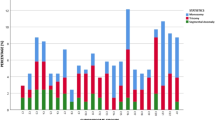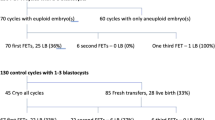Abstract
Purpose
This study aimed to determine if patients with infertility or recurrent pregnancy loss have higher rates of embryo aneuploidy than fertile controls.
Methods
This was a retrospective review of all pre-implantation genetic screening (PGS) cases processed by a single reference lab prior to March 2014 after a blastocyst biopsy. Cases were excluded if no indication for PGS was designated or patients were translocation carriers. The fertile control group consisted of patients undergoing IVF with PGS for sex selection only. The comparison cohorts included those with recurrent pregnancy loss, male factor infertility, unexplained infertility, prior failed IVF, or previous aneuploid conceptions. A quasi-binomial regression model was used to assess the relationship between the dependent variable, aneuploidy rate and the independent variables, maternal age and reason for PGS. A quasi-Poisson regression model was used to evaluate the relationship between similar independent variables and the number of blastocyst biopsies per case.
Results
The initial study population consisted of 3378 IVF-PGS cycles and 18,387 analyzed trophectoderm samples. Controlling for maternal age, we observed an increased rate of aneuploidy among patients with recurrent pregnancy loss (OR 1.330, p < 0.001), prior aneuploid pregnancy (OR 1.439, p < 0.001), or previous failed IVF cycles (OR 1.356, p = 0.0012) compared to fertile controls. Patients with unexplained and male factor infertility did not have a significantly different aneuploidy rate than controls (p > 0.05). The increase in aneuploidy in patients with RPL and prior IVF failure was driven by both an increase in meiotic (OR 1.488 and 1.508, p < 0.05) and mitotic errors (1.269 and 1.393, p < 0.05) relative to fertile controls, while patients with prior aneuploid pregnancies had only an increased risk of meiotic error aneuploidies (OR 1.650, p < 0.05).
Conclusions
Patients with recurrent pregnancy loss, previous IVF failures, and prior aneuploid pregnancies have a significantly higher, age-independent, aneuploidy rate compared to patients without infertility.


Similar content being viewed by others
References
Hodes-Wertz B, Grifo J, Ghadir S, et al. Idiopathic recurrent miscarriage is caused mostly by aneuploid embryos. Fertil Steril. 2012;98:675–80.
Harton GL, Munné S, Surrey M, et al. Diminished effect of maternal age on implantation after preimplantation genetic diagnosis with array comparative genomic hybridization. Fertil Steril. 2013;100:1695–703.
Franasiak JMFE, Hong KH, Werner MD, Upham KM, Treff NR, Scott RT Jr. The nature of aneuploidy with increasing age of the female partner: a review of 15,169 consecutive trophectoderm biopsies evaluated with comprehensive chromosomal screening. Fertil Steril. 2014:656–63.
Taylor TH, Patrick JL, Gitlin SA, Crain JL, Wilson JM, Griffin DK. Blastocyst euploidy and implantation rates in a young (<35 years) and old (≥35 years) presumed fertile and infertile patient population. Fertil Steril. 2014;102:1318–23.
Demko ZP, Simon AL, McCoy RC, Petrov DA, Rabinowitz M. Effects of maternal age on euploidy rates in a large cohort of embryos analyzed with 24-chromosome single-nucleotide polymorphism-based preimplantation genetic screening. Fertil Steril. 2016;105:1307–13.
Shahine LK, Marshall L, Lamb JD, Hickok LR. Higher rates of aneuploidy in blastocysts and higher risk of no embryo transfer in recurrent pregnancy loss patients with diminished ovarian reserve undergoing in vitro fertilization. Fertil Steril. 2016;106:1124–8.
Katz-Jaffe MG, Surrey ES, Minjarez DA, Gustofson RL, Stevens JM, Schoolcraft WB. Association of abnormal ovarian reserve parameters with a higher incidence of aneuploid blastocysts. Obstet Gynecol. 2013;121:71–7.
McCoy RC, Demko ZP, Ryan A, et al. Evidence of selection against complex mitotic-origin aneuploidy during preimplantation development. PLoS Genet. 2015;11:e1005601.
Johnson DS, Gemelos G, Baner J, et al. Preclinical validation of a microarray method for full molecular karyotyping of blastomeres in a 24-h protocol. Hum Reprod. 2010;25:1066–75.
Templado C, Vidal F, Estop A Aneuploidy in human spermatozoa. Cytogenet Genome Res. 2011;133:91–9.
Templado C, Uroz L, Estop A. New insights on the origin and relevance of aneuploidy in human spermatozoa. Mol Hum Reprod. 2013;19:634–43.
Hong K, Werner M, Franasiak J, et al. Superovulation does not increase embryonic aneuploidy: a prospective evaluation of aneuploidy in natural IVF cycles with comparison to 15,169 embryos from age controlled peers who had superovulation. Fertil Steril. 2014:e41–e2.
Qi ST, Liang LF, Xian YX, Liu JQ, Wang W. Arrested human embryos are more likely to have abnormal chromosomes than developing embryos from women of advanced maternal age. J Ovarian Res. 2014;7:65.
Coates A, Hesla JS, Hurliman A, et al. Use of suboptimal sperm increases the risk of aneuploidy of the sex chromosomes in preimplantation blastocyst embryos. Fertil Steril. 2015;104:866–72.
Neyer A, Zintz M, Stecher A, et al. The impact of paternal factors on cleavage stage and blastocyst development analyzed by time-lapse imaging-a retrospective observational study. J Assist Reprod Genet. 2015;32:1607–14.
Xue Z, Huang K, Cai C, et al. Genetic programs in human and mouse early embryos revealed by single-cell RNA sequencing. Nature. 2013;500:593–7.
Author information
Authors and Affiliations
Corresponding author
Rights and permissions
About this article
Cite this article
Kort, J.D., McCoy, R.C., Demko, Z. et al. Are blastocyst aneuploidy rates different between fertile and infertile populations?. J Assist Reprod Genet 35, 403–408 (2018). https://doi.org/10.1007/s10815-017-1060-x
Received:
Accepted:
Published:
Issue Date:
DOI: https://doi.org/10.1007/s10815-017-1060-x




